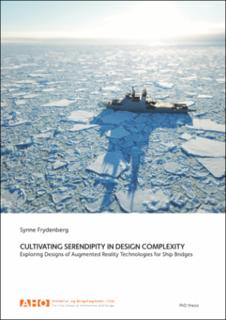Cultivating Serendipity in Design Complexity. Exploring Designs of Augmented Reality Technologies for Ship Bridges
Doctoral thesis
Submitted version
Permanent lenke
https://hdl.handle.net/11250/3123107Utgivelsesdato
2024Metadata
Vis full innførselSamlinger
- Design [33]
Sammendrag
Designing augmented reality (AR) systems for ship bridges poses intricate challenges for interaction designers due to the unique complexities involved in working with this novel interaction material in a dynamic and unpredictable environment. The absence of established design precedents and guidelines for AR systems exacerbates these challenges, thereby reflecting a broader need for guidance in navigating the rapidly evolving digital landscape of interaction design.
This thesis aims to explore and identify how design complexity can be effectively managed by introducing serendipity into the design process. Employing a research-by-design and research-into-design approach, this study utilises embedded case studies to contextualise design complexity within the specific context of designing AR technology for ship bridges. It develops conceptual frameworks, practical methods, tools, and approaches to illustrate how serendipity mechanisms and qualities can be cultivated and pragmatically integrated into the design process.
Further, this research highlights that designing AR systems for ship bridges entails grappling with various complexities, including interconnected systems, unfamiliar environments, and the challenge of assessing efficiency, user experience, and situational awareness in highrisk domains. Limited research and practice in interaction design further emphasise the need for adaptable frameworks and establishment of design precedents.
In this thesis, the navigation of design complexity is conceptualised through the deliberate cultivation of serendipity across different aspects of the design process. The case studies provide insights into an effective, pragmatic strategy that can be employed by interaction designers, stakeholders, and users in exploratory, practice-led design. This approach defines design complexity along two dimensions—design requirements and formgiving concerns—to support sensemaking and decision-making in a complex design landscape. Additionally, it conceptualises serendipity mechanisms, values, and qualities, thereby promoting attentiveness to serendipitous cues, recognition of patterns, seizing of opportunities, and creating of conducive conditions for serendipity.
The outcomes of the case studies include conceptual frameworks and design exemplars that contribute to the development of design precedents and practical support for interaction designers working in the maritime domain. In addition, this research—conducted through design—also informs research in design by exploring how design complexity in real world cases are navigated and cultivated for serendipitous outcomes in various design processes.
As the discipline of interaction design grapples with the challenges posed by novel interaction materials, including issues like unfamiliarity, technical complexity, and novel formgiving qualities, alongside the evolving digital ecosystem, there is a pressing need to establish new strategies for managing design complexity and harnessing the potential of unexpected discoveries. This thesis contributes to the ongoing evolution of interaction design by providing conceptual frameworks, practical tools, and design exemplars that not only describe but also contextualise the cultivation of serendipity within the complexities of real-world design scenarios, thereby empowering interaction designers to navigate the uncharted territories of emerging interaction materials and the everexpanding digital landscape.
